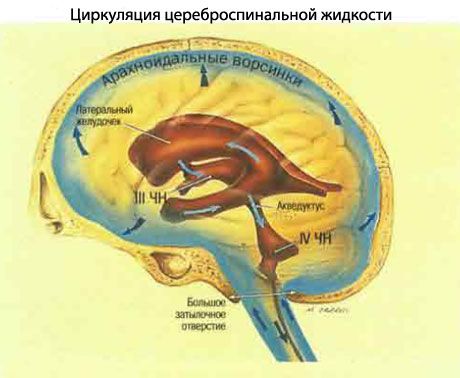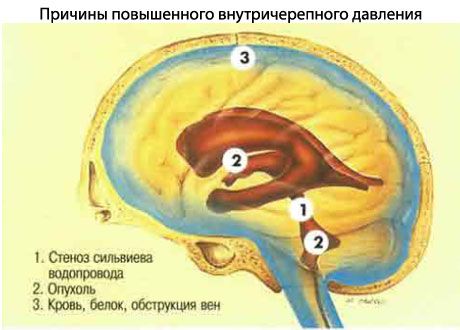Increased intracranial pressure (intracranial hypertension)
Last reviewed: 23.04.2024

All iLive content is medically reviewed or fact checked to ensure as much factual accuracy as possible.
We have strict sourcing guidelines and only link to reputable media sites, academic research institutions and, whenever possible, medically peer reviewed studies. Note that the numbers in parentheses ([1], [2], etc.) are clickable links to these studies.
If you feel that any of our content is inaccurate, out-of-date, or otherwise questionable, please select it and press Ctrl + Enter.
Causes of increased intracranial pressure
Causes of increased intracranial pressure may be as follows:
- Occlusion of the ventricular system in congenital or acquired lesions.
- Volumetric intracranial processes, including hemorrhages.
- Disorders of the absorption of cerebrospinal fluid by granulation of the arachnoid, which can be damaged in diseases such as meningitis, subarachnoid hemorrhage or brain injury.
- Idiopathic intracranial hypertension (brain pseudotumor).
- Diffuse swelling of the brain after a blunt head injury.
- Severe systemic hypertension.
- Hypersecretion of the CSF by the tumor of the choroid plexus, which is very rare.
Liquor circulation
- Cerebrospinal fluid (CSF) is formed by choroid plexuses in the ventricles of the brain.
- Leaves the lateral ventricles, entering the third ventricle through the opening of the Monroe.
- From the third ventricle through the sylvium the water supply enters the fourth ventricle.
- From the fourth ventricle cerebrospinal fluid (cerebrospinal fluid) through the holes Lyushka and Majandi passes into the subarachnoid space, flows around the spinal cord, and then washes the cerebral hemispheres.
- Absorbed in the venous drainage system of the brain through granulation of the arachnoid membrane.

The normal pressure of the cerebrospinal fluid during lumbar puncture <80 mm water. Art. In infants, <% mm in children and <210 mm of water. Art. - in adults.
Symptoms of increased intracranial pressure
Symptoms of increased intracranial pressure consist in a pressing headache, vomiting, swelling of the nipple of the optic nerve.
With a prolonged increase in intracranial pressure, the level of consciousness decreases, the weakened or asymmetrical reaction of the pupils gradually disappears completely, hypertension and bradycardia, loss of consciousness, and death are noted.
Features of increased intracranial pressure in children
- The relatively large head volume and weak neck muscles make the child’s brain more susceptible to trauma associated with acceleration-braking.
- In children younger than 2 years of age, brain swelling can be compensated for by the expansion of the bones of the skull and can be assessed by monitoring the state of fontanelles and measuring head circumference. Their skull fractures are less typical than in adults.
- Wounds of the soft tissues of the head and intracranial hematomas can cause hypotension due to the relatively large size of the head and a small BCC.
- Intracranial hematomas requiring surgical treatment are less common than in adults (20-30% of TBI in children and - 50% in adults).
- Cerebral blood flow in children is higher than in adults, and this to some extent can provide "protection" against ischemic damage.
- Neurological outcomes in children are better than in adults with the same number of points on the ScKG after resuscitation.
Where does it hurt?
What's bothering you?
Hydrocephalus
Hydrocephalus is an expansion of the ventricles.
Increased intracranial pressure can be associated with two types of hydrocephalus.
Communicating hydrocephalus, in which the cerebrospinal fluid without difficulty passes from the ventricular system into the subarachnoid space. The obstruction of the liquor duct is located in the basal cisterns or in the subarachnoid space, where absorption by pachyon granulations may be disturbed.
Uncooperative hydrocephalus is associated with a disturbance of the CSF current in the ventricular system or in the outlets of the fourth ventricle. Because of this, the cerebrospinal fluid does not reach the subarachnoid space of the space.
Symptoms of hydrocephalus
Systemic symptoms of hydrocephalus
- Headaches can appear at any time of the day, especially in the morning, which can interrupt sleep. As a rule, pains that increase within 6 weeks lead the patient to a doctor. Headaches can be generalized or localized and aggravated by head movements, stooping, or coughing. Patients suffering from headaches earlier may report a change in their nature. Very rarely, headaches may be absent.
- Sudden nausea and vomiting, often severe, can relieve a little headache. Vomiting can be an independent symptom or precede the appearance of headaches within a month, especially in patients with tumors of the fourth ventricle.
- Disturbance of consciousness can be mild, with drowsiness and drowsiness. Sudden significant disturbances indicate damage to the brain stem with a tentorial or cerebellar wedge and require urgent action.
Visual symptoms of hydrocephalus
- Transient visual disturbances lasting several seconds are frequent in patients with congestive disc.
- Horizontal diplopia is caused by the tension of the abducent nerve over the pyramid. This is a false topical symptom.
- Visual disturbances appear later in patients with secondary atrophy of the optic nerve due to a long-existing stagnant disc.
Idiopathic intracranial hypertension
Idiopathic intracranial hypertension deserves special mention, since an ophthalmologist may also be involved in its treatment. Idiopathic intracranial hypertension is defined as increased intracranial pressure in the absence of intracranial volume formation or expansion of the ventricles due to hydrocephalus. Although idiopathic intracranial hypertension is not life-threatening, persistent visual impairment due to congestive discs is possible. 90% of patients are obese women of childbearing age, often with amenorrhea. Intracranial hypertension can also be caused by medications, including tetracyclines, nalidixic acid, and iron supplements.
 [24]
[24]
Features of idiopathic increased intracranial pressure
- Complaints and symptoms of increased intracranial pressure, as described previously.
- Lumbar puncture reveals pressure> 210 mm of water. Art. Pressure may also be increased in obese patients with normal intracranial pressure.
- Neurological studies show normal or small and slit-like ventricles.
 [25]
[25]
Idiopathic increased intracranial pressure
In most patients, the course is long, with spontaneous relapses and remissions, in some patients it can last only a few months. Mortality is low, visual disturbances are frequent and sometimes severe.

How to recognize increased intracranial pressure?
- Intracranial pressure of more than 25 mm Hg. Art., measured by intraparenchymal microtransducer or external ventricular drainage, the pressure of the cerebrospinal fluid in the lateral ventricle is the “gold standard” for measuring intracranial pressure.
- Identified anomalies of intracranial pressure waves often appear due to phase cerebral vasodilation in response to a drop in cerebral perfusion pressure (MTD) and disappear with an increase in blood pressure.
- the plateau ("A") of waves paroxysmally grows up to 50-100 mm Hg. Art. (usually against the background of initially high pressure) and usually lasts several minutes (up to 20 min);
- Waves “B” - significantly shorter fluctuations, lasting about a minute and reaching 30-35 mm Hg at the peak. V.;
- abnormal waves of intracranial pressure reflect a decrease in intracranial compliance.

Treatment of increased intracranial pressure
The treatment of increased intracranial pressure has two goals - reducing headaches and preventing blindness.
Regular perimetry is important for detecting initial and progressive changes in the visual field.
Treatment of increased intracranial pressure requires the use of the following drugs and techniques:
- Diuretics, such as acetazolamide or thiazides, usually reduce headache, but their effect on the preservation of visual function is unknown.
- Systemic steroids are often used briefly, and not for long because of possible complications, especially in obese patients.
- Fenestration of the optic nerve, which consists in the incision of its meninges, reliably and effectively preserves vision, if performed in a timely manner. However, headaches rarely reduces.
- Lumboperitoneal shunts may be used, but often due to insolvency they require surgical revision.
Emergency treatment of increased intracranial pressure
- Sedation and analgesia to reduce the metabolic activity of the brain and minimize blood pressure fluctuations.
- Mechanical ventilation to maintain PaO2> 13.5 kPa (100 mmHg) and PaCO2 4.0–4.5 kPa (30-34 mmHg).
- The position with the head end of the table raised by 15-20 °, the neutral position of the neck, exclude obstruction of the veins of the neck.
- Maintain an adequate MTD (> 60 mmHg. Art.), But correct hypertension if GARDEN> 130 mmHg. Art.
- Mannitol 20% (0.5 g / kg) or other osmodiuretic.
 [31], [32], [33], [34], [35], [36]
[31], [32], [33], [34], [35], [36]
Further management
- Maintain MTD> 60 mm Hg. Art. To ensure adequate brain oxygenation by volume replacement therapy and inotropic / vasopressor.
- Treat blood pressure if it rises above the upper limit of autoregulation (CAD> 60 mmHg) to minimize vasogenic brain swelling, using short-acting drugs such as labetalol and esmolol.
- Moderate hyperventilation up to PaCO2 4.0-4.5 kPa (30-34 mm Hg). Hyperventilation up to PaCO2 <4.0 kPa (30 mmHg) is permissible only under conditions of monitoring brain oxygenation (for example, using oximetry in the jugular vein) - abuse of hyperventilation can aggravate cerebral ischemia by further reducing the critically low cerebral blood flow.
- Treat hyperthermia.
- Think of moderate induced hypothermia (target: 34 SS). Although prospective randomized studies have not proven an improvement in treatment outcomes with this approach, a moderate decrease in temperature effectively reduces increased intracranial pressure.
- Mannitol (0.5 g / kg), usually in the form of a 20% solution.
- Drainage of cerebrospinal fluid through a ventricular catheter - effectively reduces reduces intracranial pressure, but this procedure is invasive and not without risk.
- Removal of a bone flap (decompressive craniectomy) with TMT plasty is a therapeutic approach in case of intracranial hypertension refractory to conventional therapy.
 [37]
[37]
Использованная литература

